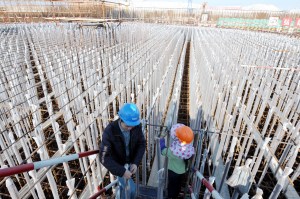 China announced via its state-run media yesterday that more nuclear power plants will be built during the nation’s next Five Year Plan, from 2011-2015. It’s not exactly new news, per se, as it’s been well known that China’s nuclear power sector has been expanding for some time in concert with the nation’s goal to generate 15% of its power by non-fossil energy by 2020. China has 13 nuclear reactors in operation today, and another 25 are under construction. By 2015, China’s investment in nuclear power production is set to reach $75 billion.
China announced via its state-run media yesterday that more nuclear power plants will be built during the nation’s next Five Year Plan, from 2011-2015. It’s not exactly new news, per se, as it’s been well known that China’s nuclear power sector has been expanding for some time in concert with the nation’s goal to generate 15% of its power by non-fossil energy by 2020. China has 13 nuclear reactors in operation today, and another 25 are under construction. By 2015, China’s investment in nuclear power production is set to reach $75 billion.
The reiteration of this plan, which would slow the increase in China’s emissions, followed close on the heels of a somewhat more puzzling announcement last week. The government heralded that the state-owned China National Nuclear Corporation (CNNC) had achieved a breakthrough in nuclear fuel reprocessing – or the use of nuclear reactor leftovers to make more fuel – thereby potentially saving China the cost and insecurity of having to import foreign mined uranium and paving a path forward in closing the nation’s nuclear fuel cycle.
The announcement was odd both because it wasn’t clear technologically how this process was different than other existing reprocessing technology, widely used in Europe and Japan, among other places. (The U.S., despite its own recent renewed interest in nuclear power, has not reprocessed fuel since the Carter administration for fear that plutonium, a byproduct, could get into the wrong hands.) The reprocessing also took place in a very small pilot project, which, to mobilize on a national scale, doesn’t solve China’s having to rely on foreign uranium anytime soon. Ian Hore-Lacy, the director public communications at the World Nuclear Association in London, calls says it amounted to little more than “conventional reprocessing at an experimental scale” – in other words, not a lot.
Reprocessing has to be politically attractive in Beijing, which would like very much to be self-reliant in its uranium supply but, as in so many other resources, is not. Kazahkstan (an increasingly wary neighbor) has the world’s largest known uranium stores, followed by Canada and Australia. There are rumblings that the world could run out of uranium before the turn of the next century, but Hore-Lacy points out that such estimates are wrongly based on known supplies. “Once the price goes up, there is all sorts of will [to tap new uranium sources],” he says. “Once the price goes up, you have a strong incentive.”
China’s announcement, for its part, did not have much of an effect on uranium prices except to move them up a notch, which, as pointed out by James Areddy on China Real Time last week, was a bit counterintuitive. Prices should have moved lower “if the largest future consumer had rid itself of the need to buy fresh supplies,” he wrote.
Where China is becoming more self-sufficient is in design and construction of its nuclear reactors. According to official statistics, the percentage of homegrown tech and equipment went from 55 to 77% last year alone, though China still works actively with international partners like U.S., Russia and France. Two new Russian reactors, due to go online in 2018 and 2019, use some of the most advanced nuclear technology in the world for their efficient use of uranium.
China’s break-neck pace has not, of course, been without its critics. In a vast country where corners have been known to get cut in construction and regulation, and all too often with fatal consequences, safety concerns loom large. And the last time that a nation tried to expand its nuclear sector so quickly, Three-Mile Island happened. Though no major incidents have been in the last 15 years, a fuel rod crack and small radiation leak at the Daya Bay nuclear plant in southern China raised concerns last year. The plant was criticized at the time for not publicizing the incidents immediately, though Hong Kong based China Light and Power (CLP), a shareholder, said the leak fell beneath the bar for requisite reporting. Just this week, however, Tuesday, the plant announced it would now announce any incident at the plant, however minor, within two days of its occurrence.
Hore-Lacy, for one, thinks China is on-track with making sure its sector is up to safety standards, describing the Daya Bay incidents as something that “can happen at any reactor at any time.” He says, “You don’t ignore it, but you don’t shut down either. It’s like if your car starts to leak oil. If there are a few spots on the garage floor, you keep an eye on it and motor on.”


